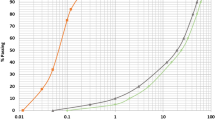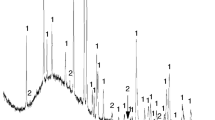Abstract
The workability and durability of a type of sustainable concrete made with steel slag powder were investigated. The hydrated products of cement paste with ground granulated blast furnace slag (GGBFS) alone or with a combined admixture of GGBFS-steel slag powder were investigated by X-ray diffraction (XRD). Furthermore, the mechanism of chemically activated steel slag powder was also studied. The experimental results showed that when steel slag powder was added to concrete, the slumps through the same time were lower. The initial and final setting times were slightly retarded. The dry shrinkages were lower, and the abrasion resistance was better. The chemically activated steel slag powder could improve compressive strengths, resistance to chloride permeation and water permeation, as well as carbonization resistance. XRD patterns indicated that the activators enhanced the formation of calcium silicate hydrate(C-S-H) gel and ettringite (AFt). This research contributes to sustainable disposal of wastes and has the potential to provide several important environmental benefits.
Similar content being viewed by others
References
Singh G, Siddique R. Abrasion Resistance and Strength Properties of Concrete Containing Waste Foundry Sand (WFS) [J]. Constr. Build. Mater., 2012, 28:421–426
Saraswathy V, Muralidharan S, Thangavel K, Srinivasan S. Influence of Activated Fy Ash on Corrosion-Resistance and Strength of Concrete [J]. Cem. Concr. Compos., 2003, 25:673–680
Papayianni I, Anastasiou E. Production of High-Strength Concrete Using High Volume of Industrial By-products[J]. Constr. Build. Mater., 2010, 24:1 412–1 417
Khunthongkeaw J, Tangtermsirikul S, Leelawat T. A Study on Carbonization Depth Prediction for Fy Ash Concrete [J]. Constr. Build. Mater., 2006, 20:744–753
Lizarazo-Marriaga J, Claisse P, Ganjian E. Effect of Steel Slag and Portland Cement in the Rate of Hydration and Strength of Blast Furnace Slag Pastes [J]. J. Mater. Civil Eng. 2011, 2:153–159
Martinez-Aguilar OA, Borges PC, Escalante-García JI. Hydraulic Binders of Fluorgypsum-Portland Cement and Blast Furnace Slag. Stability and Mechanical Properties[J]. Constr. Build. Mater., 2010, 24:631–639
Binici H, Aksogan O, Gorur EB, Kaplan H, Bodur MN. Hydro-Abrasive Erosion of Concrete Incorporating Ground Blast-furnace Slag and Ground Basaltic Pumice [J]. Constr. Build. Mater., 2009, 23:804–811
Pal SC, Mukherjee A, Pathakc SR. Investigation of Hydraulic Activity of Ground Granulated Blast Furnace Slag in Concrete [J]. Cem. Concr. Res. 2003, 33:1 481–1 486
Xue YJ, Wu SP, Hou HB, Zha J. Experimental Investigation of Basic Oxygen Furnace Slag Used as Aggregate in Asphalt Mixture [J]. J. Hazard. Mater., 2006, 138:261–268
Peng YC, Hwang CL. Carbon Steel Slag as Cementitious Material for Self-Consolidating Concrete[J]. J. Zhejiang Univ. Sci. B, 2010, 11:488–494
Alanyali H, Mustafa C, Yilmaz M, Karagoz S. Concrete Produced by Steel-making Slag (Basic Oxygen Furnace) Addition in Portland Cement [J]. J. Ame. Ceram. Soc., 2009, 6:736–748
Wang Q, Yan PY. Hydration Properties of Basic Oxygen Furnace Steel Slag [J]. Constr. Build. Mater., 2010, 24:1 134–1 140
Muhmood L, Vitta S, Venkateswaran D. Cementitious and Pozzolanic Behavior of Electric Arc Furnace Steel Slags [J]. Cem. Concr. Res., 2009, 39:102–109
Manso JM, Polanco JA, Losan M, Gonzalez JJ. Durability of Concrete Made with EAF Slag as Aggregate [J]. Cem. Concr. Compos., 2006, 28:528–534
Manso JM, Gonzalez JJ, Polanco JA. Electric Arc Furnace Slag in Concrete [J]. J. Mater. Civil Eng., 2004, 11:639–645
Shi CJ. Steel Slag-Its Production, Processing, Characteristics and Cementitious Properties [J]. J. Mater. Civil Eng., 2004, 5:230–236
Altuna IA, Yılmaz IS. Study on Steel Furnace Slags with High MgO as Additive in Portland Cement[J]. Cem. Concr. Res., 2002, 32:1 247–1 249
Tsakiridis PE, Papadimitriou GD, Tsivilis S, Koroneos C. Utilization of Steel Slag for Portland Cement Clinker Production [J]. J. Hazard. Mater., 2008, 152:805–811
Wang G. Determination of the Expansion Force of Coarse Steel Slag Aggregate [J]. Constr. Build. Mater., 2010, 24:1 961–1 966
Ahmedzadea P, Sengoz B. Evaluation of Steel Slag Coarse Aggregate in Hot Mix Asphalt Concrete [J]. J. Hazard. Mater., 2009, 165:300–305
Pasetto M, Baldo N. Experimental Evaluation of High Performance Base Course and Road Base Asphalt Concrete with Electric Arc Furnace Steel Slags [J]. J. Hazard. Mater., 2010, 181:938–948
Basheer PAM, Gilleece PRV, Long AE, Mc Carter WJ. Monitoring Electrical Resistance of Concretes Containing Alternative Cementitious Materials to Assess Their Resistance to Chloride Penetration [J]. Cem. Concr. Compos., 2002, 24:437–449
Haque MN, Al-Khaiat H. Carbonization of Concrete Structures in Hot Dry Coastal Regions [J]. Cem. Concr. Compos., 1997, 19:123–129
Aruhan, Yan PY. Carbonization Characteristics of Concrete with Different Fly-ash Contents [J]. J. Chin. Ceram. Soc., 2011, 39:7–12
Collins F, Sanjayan JG. Effect of Pore Size Distribution on Drying Shrinkage of Alkali-activated Slag Concrete [J]. Cem. Concr. Res., 2000, 30:1 401–1 406
Collins F, Sanjayan JG. Cracking Tendency of Alkali-activated Slag Concrete Subjected to Restrained Shrinkage[J]. Cem. Concr. Res., 2000, 30:791–798
Grdic ZJ, Curcic GAT, Ristic NS, Despotovic IM. Abrasion Resistance of Concrete Micro-reinforced with Polypropylene Fibers [J]. Constr. Build. Mater., 2012, 27:305–312
Wang Q, Yan PY. Characteristics of Hydration Products of Steel Slag [J]. J. Chin. Ceram. Soc., 2010, 38:1 731–1 734
Author information
Authors and Affiliations
Corresponding author
Additional information
Funded by the National Natural Science Foundation of China (Nos.51208370, 51172164), and the Fundamental Research Funds for the Central Universities (No.0500219170)
Rights and permissions
About this article
Cite this article
Guo, X., Shi, H. & Wu, K. Effects of steel slag powder on workability and durability of concrete. J. Wuhan Univ. Technol.-Mat. Sci. Edit. 29, 733–739 (2014). https://doi.org/10.1007/s11595-014-0988-2
Received:
Accepted:
Published:
Issue Date:
DOI: https://doi.org/10.1007/s11595-014-0988-2




